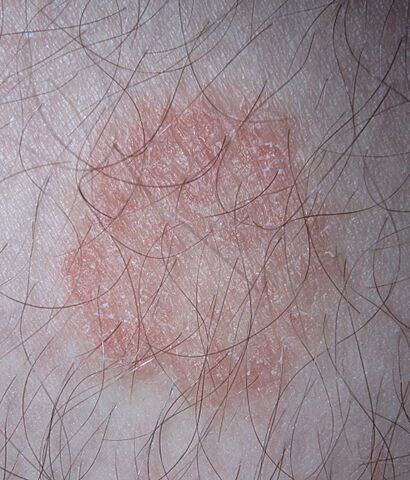Dermatophytosis facts for kids
Quick facts for kids Dermatophytosis |
|
|---|---|
| Synonyms | Ringworm, tinea |
 |
|
| Ringworm on a human leg | |
| Symptoms | Red, itchy, scaly, circular skin rash |
| Causes | Fungal infection |
| Risk factors | Using public showers, contact sports, excessive sweating, contact with animals, obesity, poor immune function |
| Diagnostic method | Based on symptoms, microbial culture, microscopic examination |
| Similar conditions | Dermatitis, psoriasis, pityriasis rosea, tinea versicolor |
| Prevention | Keep the skin dry, not walking barefoot in public, not sharing personal items |
| Treatment | Antifungal creams (clotrimazole, miconazole) |
| Frequency | 20% of the population |
Ringworm, also called dermatophytosis or tinea, is a common fungal infection that affects your skin. It can also show up on your hair or nails. It often looks like a red, itchy, and scaly rash that forms a circle. Sometimes, hair can fall out in the affected area.
You might start to see symptoms about four to fourteen days after coming into contact with the fungus. There are different types of ringworm, and they are usually named after the part of the body they affect. You can even have ringworm in more than one place at the same time.
About 40 different types of fungi can cause ringworm. These fungi are often from types like Trichophyton, Microsporum, or Epidermophyton. You might be more likely to get ringworm if you use public showers, play contact sports like wrestling, sweat a lot, or are around animals. Having a weaker immune system can also increase your risk. Ringworm can spread from animals to people, or from one person to another. Doctors often diagnose ringworm by looking at the rash and hearing about your symptoms. They might also confirm it by looking at a skin sample under a microscope.
How You Get Ringworm
Fungi that cause ringworm love warm, wet places. This includes areas like locker rooms, swimming pools, and even skin folds on your body. Because of this, ringworm can spread if you use exercise machines that haven't been cleaned. Sharing towels, clothes, shoes, or hairbrushes can also spread the infection.
Spotting Ringworm
Doctors can usually tell if you have a ringworm infection by checking your skin and asking about your symptoms. They might also take a small scraping of your skin to look at it closely under a microscope. This helps them confirm if it's a fungal infection.
Keeping Ringworm Away
There are simple ways to help prevent ringworm:
- Try not to share clothes, sports gear, towels, or bed sheets with others.
- Wash your clothes in hot water with soap if you think they might have touched ringworm.
- Don't walk barefoot in public places like locker rooms. Wear shoes or sandals instead.
- Be careful around pets that have bald spots, as they can sometimes carry the fungus.
Ringworm Through Time
Ringworm has been around for a very long time! People have known about it since ancient history. In the past, around the early 1900s, people tried different ways to treat ringworm. Today, we have much safer and more effective treatments.

